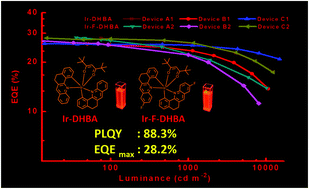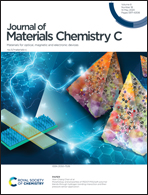Efficient red phosphorescent Ir(iii) complexes based on rigid ligands with high external quantum efficiency and low efficiency roll-off†
Abstract
The rigid ligands in red phosphorescent Ir(III) complexes can suppress the vibration and rotation around metal ions to maximize the utilization of low energy singlet and triplet states, thus greatly reducing the probability of non-radiative decay. In this paper, the coordination groups (phenyl and quinolinyl) are fused by a cyclohexyl group to produce rigidified ligands (5,6-dihydro-benzo[c]acridine and 9-fluoro-5,6-dihydro-benzo[c]acridine). A bulky ancillary ligand (2,2,6,6-tetramethylheptane-3,5-dione) was applied for the synthesis of Ir(III) complexes (Ir-DHBA and Ir-F-DHBA) to minimize the intimate interactions between Ir(III) molecules and consequently to reduce triplet–triplet annihilation and triplet-polaron annihilation. When the two Ir(III) complexes were applied as dopants in organic light-emitting diode (OLED) devices, they both showed excellent electroluminescence (EL) performance. The device based on Ir-DHBA demonstrated a low efficiency roll-off with a maximum external quantum efficiency (EQE) of 26.0%, 25.3% EQE at a brightness of 1000 cd m−2 and 22.7% EQE at 10 000 cd m−2. The device based on Ir-F-DHBA (at a doping ratio of 3%) with an exciplex as a co-host showed a maximum EQE of over 28% with Commission Internationale de l’Eclairage (CIE) coordinates of (0.61, 0.39) and an EL emission peak at 600 nm.



 Please wait while we load your content...
Please wait while we load your content...